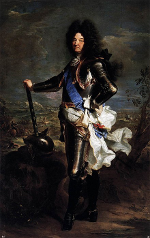The Unparalleled Reign of the Sun King, Louis XIV of France
Part 3: War after War Distrustful of France's power and disdainful of the king's treatment of the Huguenots, other European nations banded together in the League of Augsburg and declared war on France. Facing off against the armies of Louis XIV were the Dutch Republic, England, the Holy Roman Empire, Portugal, Savoy, Scotland, and Sweden. French troops were more than equal to all of those combatants. This conflict also had a North American element, in what was called King William's War; there, the fighting was largely in what is now Canada and was focused on the fur trade. The war lasted nine years and drained the resources of all countries involved; France, however, lost no significant territory. The 1697 Treaty of Rijswijk ended the war, in Europe and in North America. A mere four years later, France was knee-deep in another war, this time over who would take the throne of Spain. The King, Charles II, had died, and Louis wanted his own grandson, Philip V, to stay in power; other countries had other ideas, and the War of the Spanish Succession raged. In fact, this conflict would continue for another 13 years (1701–1714). French forces lost battle after battle but rallied near the end of the war. The Peace of Utrecht sealed the peace. The French government coffers were drained again, and famine was not uncommon. Confidence in the monarch was by this time at an all-time low. Louis oversaw all of this upheaval from Versailles, the opulent palace that he had built in the countryside in 1661–1682. It was there that he died, of gangrene, on Sept. 1, 1715. He had been on the throne for 72 years, a reign longer than any other European monarch up to that time. His oldest son and grandson had preceded him in death, so his successor was his 5-year-old great-grandson, who became Louis XV. Louis XIV is known for the long shadow he cast over his people, his country, and the rest of Europe for his several decades on the throne. He is often held up as the quintessential absolute monarch. He was also the namesake of a large swathe of land in North America. He had directed an ambitious program of exploration in the New World. The French explorer René-Robert Cavelier, Sieur de La Salle reached the middle of what is now the United States in 1682; specifically, La Salle reached the Mississippi River and claimed all of the land drained by the expansive river for France and, further, named it after his king. This was the genesis of the Louisiana Territory, which, after the Louisiana Purchase in 1803, became part of the U.S. Louis also lent his name to an American state, Louisiana, which joined the Union in 1812. |
|
Social Studies for Kids
copyright 2002–2025
David White





